Inside Story: Designer Annysa LaMantia creates home interiors for the stars
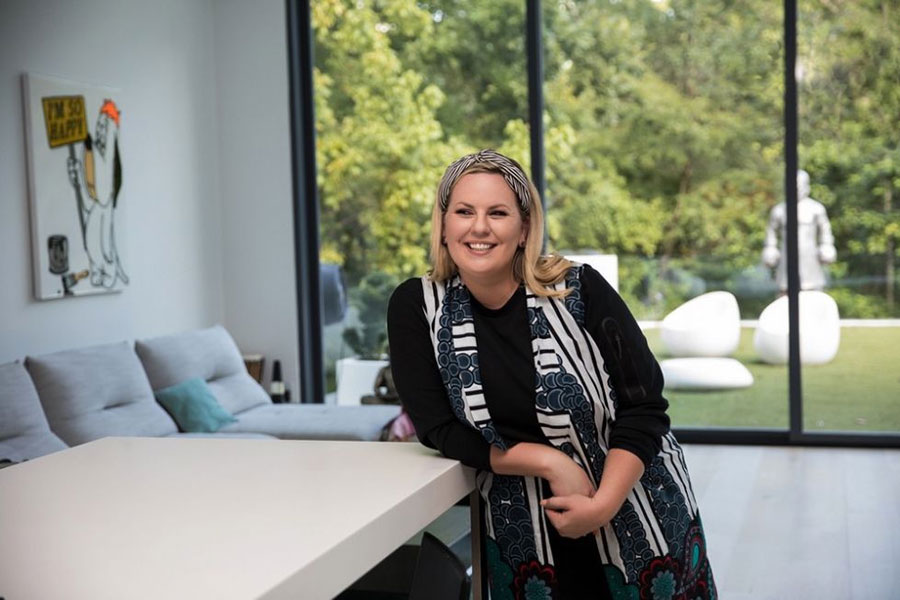
When it comes to interior design for her high-profile clients, Annysa LaMantia, BS’09, literally thinks of everything. Working on a recent project for Grammy-winning rapper Lil Baby, LaMantia designed, commissioned, and imported a 2,500-pound Italian marble bathtub which was so large it had to be brought inside through a window. A forklift driver was hired to navigate the tub through a narrow side yard, and the bathroom floors also had to be reinforced to support its weight when filled with water.
LaMantia is the creative director of the Atlanta-based Annysa LaMantia studio. She has designed luxury digs for entertainers Bobby Valentino, Khalid, T.I., and 2 Chainz, among others. And she’s currently designing for some new high-profile clients, but the ink on those non-disclosure agreements is still very wet. LaMantia has also expanded into product design, including a rug collection with a brand from Copenhagen, Denmark.
LaMantia earned interior design and studio art degrees from the IU Eskenazi School of Art, Architecture + Design and also had a special focus on entrepreneurship in the Kelley School of Business, which has helped her in running her own company. During her IU days, LaMantia also covered the arts for The Indiana Daily Student and interviewed a number of notable artists, from musicians to poets, which inspired her on a creative level.
After graduation, LaMantia spent several years working in Atlanta for the high-end furniture brand Roche Bobois, which included a lot of international travel, particularly to Europe. She also took time to soak up as much knowledge as she could about furniture design in places like Milan and Florence, Italy, learning about upholstering and furniture construction “at a very deep level.”
Her artistic vision for the future includes marrying product design with interior spaces “in a way that [can] be enjoyed by a lot of people,” she says.
The following interview with Annysa LaMantia was conducted in February, 2025.
Learn more about Annysa’s interior design work
You graduated from IU in 2009. And you have interior design and studio art degrees from the IU Eskenazi School of Art, Architecture + Design. Is that right?
Annysa Lamantia: That’s correct. I do. And I had a special focus on entrepreneurship as well with the Kelley School of Business.
And your professional title is creative director? You have your own design firm?
AL: I do. I refer to myself as the creative director.
I was interested to see that the ball really got rolling, in terms of your more high-profile clients, with American R&B singer Bobby Valentino (who now performs as Bobby V.).
AL: Yeah, I would say he was my first client in Atlanta, and he was my first celebrity client.
How did that come about?
AL: At the time, the recession was still very prevalent, and, you know, just coming out of college as an interior designer with, like, a full-blown recession is not the best of conditions. You partner that with this being my first time in the workforce and not really knowing what’s normal and not normal for the for the climate of the industry. And I was in a new city. I was in Atlanta.
So, I was selling furniture at a high-end, contemporary showroom called Roche Bobois in Atlanta, and a young woman walked in. She was looking around for some time, and we had a conversation. She said, ‘Look, I’m actually in the market for furniture to stage a music video shoot, but we don’t really have a budget for the for the staging.’ And, she said, ‘Are you familiar with Bobby Valentino?’
And I was, and it just came to me to suggest that they shoot the music video in the showroom instead of renting anything. I just thought that was a creative way to see if he could come into the showroom, and we could meet their needs and see, you know, if we could kind of engage with him. And, so, she agreed to that.
The next night, I think it was, he came with a large group of people, and they filmed a music video in our showroom at night. And he said, ‘You know, Annysa, I’m glad this happened, because I have a brand-new condo and there’s no furniture in it, and I would love to talk to you about that’. He ended up asking me to design the whole condo.
So, that was kind of your entrée [into celebrity designing] then?
AL: It was, and we’re still friends to this day. I actually spoke to him earlier today, and we’ve worked on projects since. My relationship with him really opened a lot of doors in Atlanta in the music industry early on in my career, which was a huge blessing.
So, about the process itself, I imagine that there are hundreds or thousands of little decisions that need to be made in terms of a home interior space. How detailed do you get when working on an entire home design? Is it all the way down to, like, switch plate covers and doorknobs, or are there some other intangibles that you control with some of the decisions you make? I’m curious to know what goes into all that.
AL: Oh, yeah. It’s very detailed. It does get into a lot of minutiae for decision-making. Given the scope of work of each project can be a little bit different, we do everything from new-build construction to home renovations. And we end up doing a lot of those properties that need some updating. And so, we do a very high-view, high-level kind of furniture layouts and things that are a little bit more broad scope.
Then, we do get into fine details, like, to your point, doorknobs, finishes, fixture selections, even sometimes the type of mechanism used to open a door that may or may not have a pull on it. We do hidden doors a lot. Those require specialty mechanisms—so that you don’t see the hardware—and some construction wherewithal to implement.
And we work collaboratively with a lot of really amazing builders as well to bring our ideas to life. A lot of times, there’s quite a collaborative effort to get certain things to their full potential. We even deal with structural engineers and get stamps and certifications for the floors to perhaps carry the load of something that we want to implement.
For example, we just did a 2,500-pound stone tub that we had to fit through a window because it was so oversized. It was a tub I had designed out of marble. We had it made overseas. That was a whole process to design it and have it made. Then to ship it is another process. Importing and then finally get it into the house is another [process.] We preemptively understood we were going to have some challenges. We had to contact a window company to take out the glass. We had to contact a forklift driver to forklift the tub through a particularly tight side yard, which was an all-day event. Then, we also had to have the floors reinforced. The tub weighed 2,500 pounds, but the water alone would weigh 4,000 pounds.
So, there are a lot of details when you’re doing custom work. A lot of the time when you see interior design outcomes that are really amazing, that means that a lot had to go into them. A lot of contractors will tell you ‘No’ if you’re asking them to do something they’ve never done before. It takes a really special effort to make these unique spaces come to life.
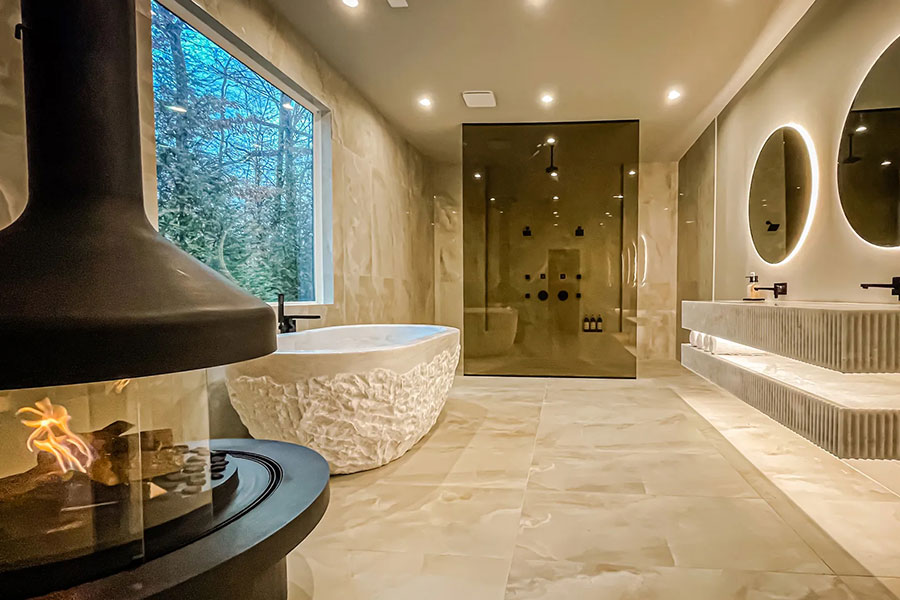
Wow! How big is your team?
AL: There’s seven of us right now and we’re growing. It’s all hands on deck. But then that’s just my design team. That’s not counting all the people we collaborate with. So, the extended family is quite large.
So, hidden doors! Have you ever done one of those library bookcases that turns and becomes a wall or something crazy like that?
AL: Similar ideas. We have a lot of clients who have safes and things that they’ve stored that they don’t want to have access to. So, we find creative ways to hide them.
We had a really fun response on the internet about… the rooms that toilets are in. We did, like, a hidden door on the water closet, and so many moms were commenting, saying, like, ‘This is a dream! My kids always bother me when I’m on the toilet. If they couldn’t find me, this would be so good!’
That’s funny. I’m curious to know about some of the intangibles that change the quality of a space. Like what about the quality of light in a space or the way a place smells. Are those some of the things that you consider when you’re making your design plans?
AL: We do. Lighting is a big factor always. We try to consider everything very holistically as we’re designing—so, like, 360 degrees. A lot of that is putting ourselves in the space as the end user, as if we were the ones navigating the space.
As it pertains to light, there’s always a consideration with different types of moods that you can create with lighting. Of course, you have natural light, which is a must, if and when possible. But then, we also have lighting that can be controlled on smart switches or from your phone which can have presets on moods. You can have more ambient lighting in the evenings, task lighting, or, just all at once, all the lights come on for things like cleaning or safety. So, we do get into lighting design in that way. And that has a huge impact on the space, as a matter of fact. I like to always give clients options with lighting.
I think you also asked about the way a place smells. There’s a system that we implement sometimes. It’s called Aroma360 and there are other brands that are similar, but, essentially, it goes into your HVAC system, and it does a slow release of a scent that you might like throughout your home. You can create the intensity levels with that. Oftentimes, if you’re in a really nice hotel in the lobby or another public space and it has a nice fragrance, that’s where that’s coming from—the HVAC system.
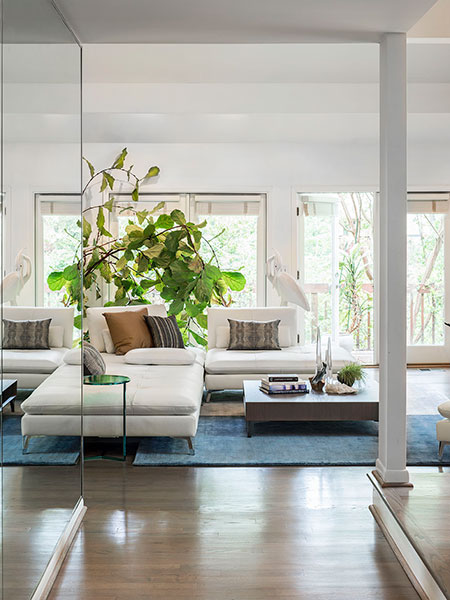
There was a quote that I found about you on your website. It says, “As a designer, she believes the most effective space is one created by translating ideas into a visual form that reflects the character of the client.” What is your process like for that?
AL: It’s a mixture of discovery. We ask a lot of questions to make sure that we’re properly understanding everything before we go so far as to assume anything at all. We’re always asking a lot of questions about functionality—the way people would like to function in their space—and getting a lot of answers.
We also have observations [about] how the client presents themselves as it pertains to fashion and clothing and taste. Also, if they’re really into anything in particular—like if they have a passion for cars or music—and just trying to get an understanding of their sensibilities about what type of environment would make them the most comfortable.
And we also analyze their existing space. What are the problems with that? What can we solve in the new design? Finding out if they like to travel and, if so, what types of places do they desire to stay? A lot of our clients that are entertainers or businesspeople that travel quite a bit, they have oftentimes a hotel that they’ll reference. They’ll say, ‘This was my favorite and this is why.’ We just try to gather a lot of information.
Some of it is intuition as well, to be honest. Something that’s hard to explain. But it’s a combination of all of those things.
Well, that’s one piece of it that I’m curious about, too. It is a kind of intuition and empathy—some intangible skills that you either have them or you don’t. You must have them in spades to do what you’re doing.
AL: [laughs] Thanks for saying that. I will be honest. When I’m working, I get these sort of downloads that I’m very aware of that are, you know, they’re coming to me as understandings, and I always trust those. And when I trust those, I really feel like I could probably equate it to a basketball going through the net without touching the backboard. It just kind of feels like the perfect landing. When I get those types of feelings, I move on them, and it usually works out be a win for everybody, which is a really great thing.
Well, that’s a very apt metaphor. We can use that to pivot and talk about IU a little bit. I saw that you used to write for the Indiana Daily Student. What did you write about? Was it anything design-related back then or was it more general?
AL: I wrote specifically for the Arts section, and I loved doing that. I remember interviewing a lot of really dynamic people. I remember speaking with Saul Williams, the poet, which was a huge honor at the time, and Hashim Mills was a wonderful music artist I was able to speak to. These people were so kind to have conversations with me, and I looked at it almost like a mentorship. Even if they didn’t realize it, that’s what it was for me.
But, you know, as I’m older now, I am a guest lecturer and mentor at the Savannah College of Art and Design (SCAD) in Atlanta. I work a lot with college-aged students, and I see there’s a really strong need for mentorship in the fields that these kids are going into. It adds so much to the education process and it sort of brings everything full circle in terms of applying what you’re being taught to what somebody is actually doing to make money in the world and survive.
So, I found that was a really dynamic addition to my education at the time—writing for the IDS—because I was able to interface with these people who were quite successful in their fields. It made an impression on me for sure, as I ventured into a similar path with my design career working with people who were very similar to these folks. So, it was a perfect marriage of my passion and getting a skill set. Because writing, I think, is an art form as well. You need it in any job, any field that you get into. Being a good writer is going to be a strong bonus to whatever skill set you have. It was a great experience for me at IU to write it for the IDS.
So, the business piece of it—the Kelley School and the arts. Was yours an arts-related business curriculum or was it a strictly separate business focus?
AL: It definitely was separate. When I was in school, I had a very clear understanding with artist parents—both my parents were artists—that there is a business element to art and that you can have a lot of talent, but you also need to know how to manage it and monetize it. So, I thought it was very important to me to understand how business operates, because I had entrepreneurs as parents. I felt that that would be a wonderful skill set to solidify in school.
I wasn’t drawn to math or accounting, but I knew that I needed to know it and that was the time to do it. I’m so glad I did. Because running my own company—which I have for the last nine years and very successfully—it’s been critical to have that foundation in business.
And, when I was at the Kelley School, we had a group project where we had to create a business opportunity and then show how it could play out. At the time, I was going around—because I’m from Bloomington as well—and every year the college students would leave furniture out. When they would move, they would just leave it out on the curb. And, so, I had spent a summer collecting some of the cooler pieces and refurbishing them, painting them, reupholstering them, and just sort of creating new life for the furniture. For my Kelley School project, I had our group propose a business plan around that idea. It won in the class, and I was quite proud of myself for bringing the design world over to the Kelley School. [laughs]
Well, yeah! And you were actually doing it in real life, too. Did you sell your refurbished stuff somewhere?
AL: I did. I had a big yard sale at the end of the summer and sold out. I think I made, like, $500 at the time. I was quite pleased.
You’ve had some very high-profile clients. I saw that there was maybe a new one that you couldn’t reveal yet. I don’t know if you’re able to or not but thought I’d ask…
AL: We do have an NDA with probably the biggest client of my life, which is so sad, because I would love to announce that person.
But there are other artists that I haven’t mentioned before that I’ve done design work with. The rapper T.I. I’ve done design work with 2 Chainz.
I’ve just had the privilege of working with some very notable people in the music industry. It has just been an honor, really. Khalid, the R&B singer. Bobby Valentino. Lil Baby. And some others I’m currently working with that haven’t really come out yet, so I don’t want to say. Part of my appeal as a designer is that I am very discreet with the privacy of clients, because security is a huge concern for a lot of my clients. It’s just a different age that we live in. So, I just try to be very mindful of that.
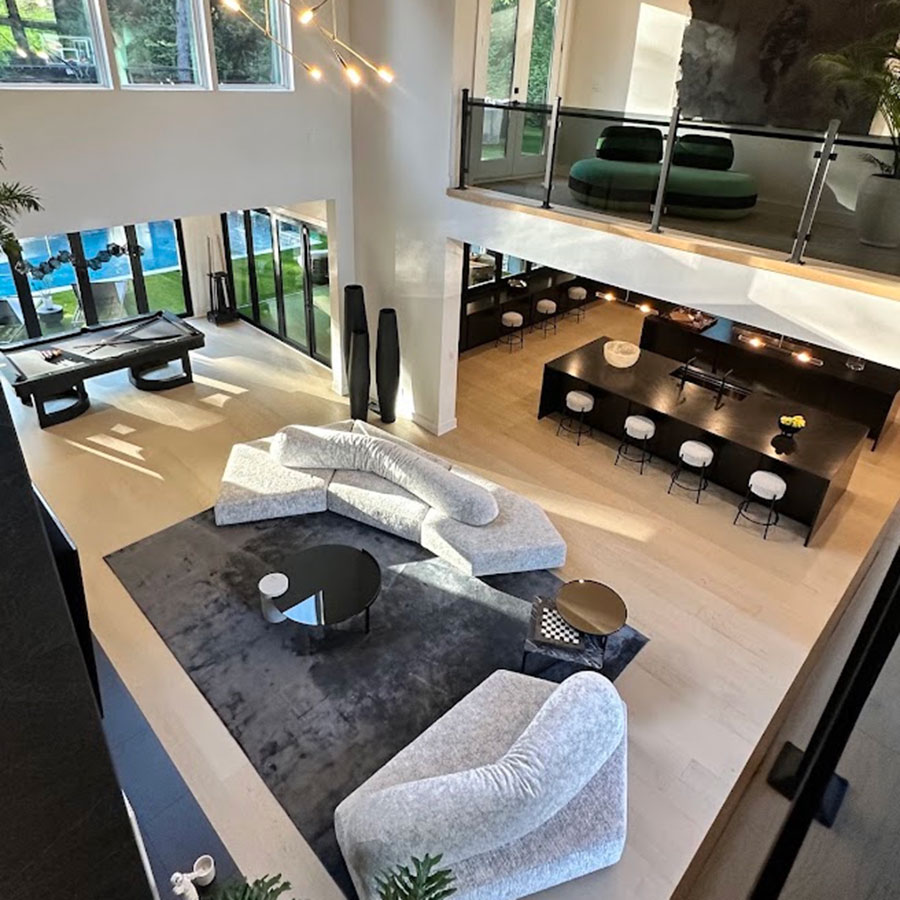
Rapper Lil Baby gives tour of his Atlanta home
See the rapper’s home, designed by Annysa LaMantia, that was featured in Architectural Digest.
Do you have a dream client or a dream project in mind? Is there something that you’ve never gotten to do that you would just love to do in the future?
AL: That’s a great question. I have a female role model who I really look up to in the interior design world. Her name is Patricia Urquiola, and she is a profound product designer, interior designer, and architect.
She’s done countless projects around the world. But one in particular that I’ve been to that I really love is a contemporary design that she was the architect of. It’s a hotel in Lake Como, Italy, and it’s called Il Sereno. In this project, she designed the architecture, the interiors, and the furniture for the entire space. And it’s sensational. I mean, it truly is sensational. The whole space is so dynamic. She has such a cool concept behind the project. That area is very well known for Riva boats—these very high-end wood boats. And the concept of the hotel is that it’s coming out of—the building looks like it’s emerging… into the sea through the mist. And it really does look like that and it’s really incredible. There’s an aquatic type of boat influence to the design, but it’s also really well done in a way where it doesn’t feel like a theme, because it’s very understated and cool.
So, I look at projects like that, and, to answer your question, I would love to design a space [including] the entire interiors and also all the products in the space, as well in a similar manner. I think that would be incredible.
I am expanding into product design. I have a rug collection that’s coming out soon with a brand from Copenhagen that I’m very excited about. I also currently have a marble collection with The Davani Group. It’s a capsule collection called the Vitality Collection.
I trained in Italy with Maurizio Manzoni to learn furniture design. He’s a world-renowned furniture designer. I really would love to marry my product design with my interior spaces in a way that could be enjoyed by a lot of people. That would be one of my dream jobs.
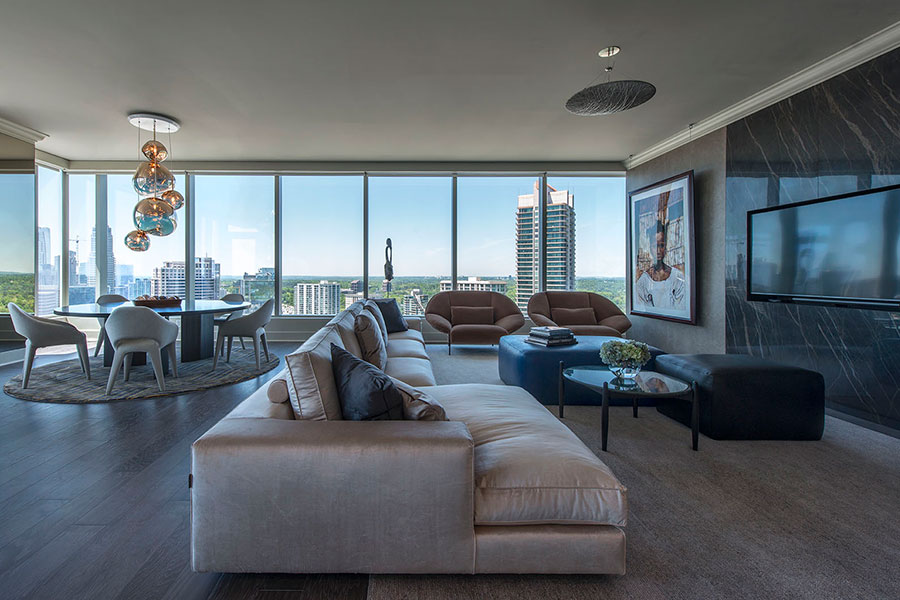
I’m thinking about the skill set that you have. Probably woodworking to some degree, reupholstery, textiles—stop me at any point here, if I’m getting stuff wrong. It’s pretty well rounded! Could you expand on that?
AL: Basically, I spent seven years working for this high-end furniture brand, and I became the buyer for their showroom. So, they would send me to France, and I’d go to this underground bunker, truly, where they would debut the next collection. They’d do this twice a year. They would have, you know, the showroom pieces that were available. It was kind of like, if you could think of Paris Fashion Week, how they show for the spring and the fall, the furniture industry also has this.
And, so, I would go, and I would get to select from this special collection of private designers that design for Roche Bobois. They would demonstrate the pieces and how they worked. They would flip them over. They’d take them apart. So, it was a lot of education in that experience. And then I would get to select the materials and finishes that I would order for our market in Atlanta.
Then, at that same time, I was investing in myself. I would break off and go to this very large world furniture fair called Salone del Mobile which is in Milan every April. Salone is like Fashion Week for furniture. It’s all these luxury brands that go there and they display their newest collections. They’re setting the trends for the world at this particular fair. It’s the biggest one in the world.
If you can imagine, like, 11 convention centers that are filled to the brim with—they actually construct stores inside of the space. So, it’s not a booth type of thing. You would think you were in a physical store. The space, the footprint—they design the walls and the flooring. They literally create, they bring the showroom to these convention centers, and they’re the top brands in the world.
So, I would go, and I would just absorb all of this information. I would see the trends. I would see the brands. I would see the colors that were coming into play. I would see the materials that were being used. And I would just inspect everything. I mean, I would go kind of ballistic. I would just, like, go crazy looking at everything and just teaching myself, you know, and learning. I did this for many years on my own. And I started to make all my connections come together.
Then, when I decided to leave the furniture store, I reached out to one of the designers that works for the brand Maurizio Manzoni and I said, ‘I would love to apprentice with you. Can we arrange this?’ And he was very open to it. So, I went to work for him in Florence. I moved. I left my job. I left everything and I worked for him.
He was contracted—he had a lot of furniture at the same fair that I’m telling you about by many, many different brands, because he was very well known. I think one time he told me, he had 50 different things there that he had designed, and so I became really inspired and crazed to do this, to do furniture design in this way.
During my time apprenticing, he took me all over the countryside where he has prototypes made for his designs. We’d go, literally, to this hillside where the cows are raised and then the leather is being stretched, and the mom and the son are upholstering the arm of a sofa. So, I really have seen construction at a very deep level.
He designed an entire collection for Salone. We went two weeks before and set the entire thing up. So, I’ve seen the whole process of how the furniture collections come to be made, the brand identities, the construction of the showrooms inside Salone and how they import everything and the prototypes. I’ve had the end-user experience as a designer. I’ve had the sales experience. I’ve had the construction-of-the-furniture experience. I’ve had the education of schooling—interior design and the business schooling. So, I have a very well-rounded idea about the industry. I’m so grateful for all my experiences giving me this collective knowledge that really helps me move forward with confidence in the work that I do.
Did you ever think that your life would turn out like it has or is it just all a good plan, and you’ve simply executed the plan?
AL: That’s a great question. I have been encouraged artistically from such a young age by my parents, by their friends, by my extended family, aunts and uncles, the friends of my parents, and everyone would have the same sentiment. It was just like, “Go for it, girl!” It was just very encouraging and [I was] very supported in that space. I know that that’s a very rare circumstance. I know a lot of people that I’ve met were not encouraged artistically at a young age and have found art later in life.
But I was [encouraged] and I’m so grateful for it, because I had a very inflated sense of ‘can-do,’ you know? I really felt like I was able in that way.
I remember specifically one of my professors redlining drawings. Kind of like, ‘Change this. Redo this.’ And she was saying that to a number of other students and she came over to me and made similar comments. And I said, ‘Thank you so much. I’ll consider your feedback. I’ll consider what you said.’ She didn’t tell me to change anything, and I didn’t. Then, the people who did [make changes], she basically ended up saying, ‘The first one was better’ to people who had spent, you know, three nights redoing things.
I just remember thinking, ‘Oh, yeah. You’ve got to really have your reasons and stick to your guns. You have to have your principles and your reasons and, if they’re strong enough, you can go forward with them. I always make it a point to ask a lot of questions and understand the way that I’m moving, so I’m moving in a very educated manner.
And there is another level of intuition that comes into play in terms of what’s for you and where you should go. I always moved in the direction of what I felt was resonating with me, and I tried to really listen to that and also simultaneously avoid things that did not seem to be for me. I think sometimes people feel forced into certain directions for various reasons, but I really had this amazing sense of being in the flow. And I really was and I’m so grateful for that.
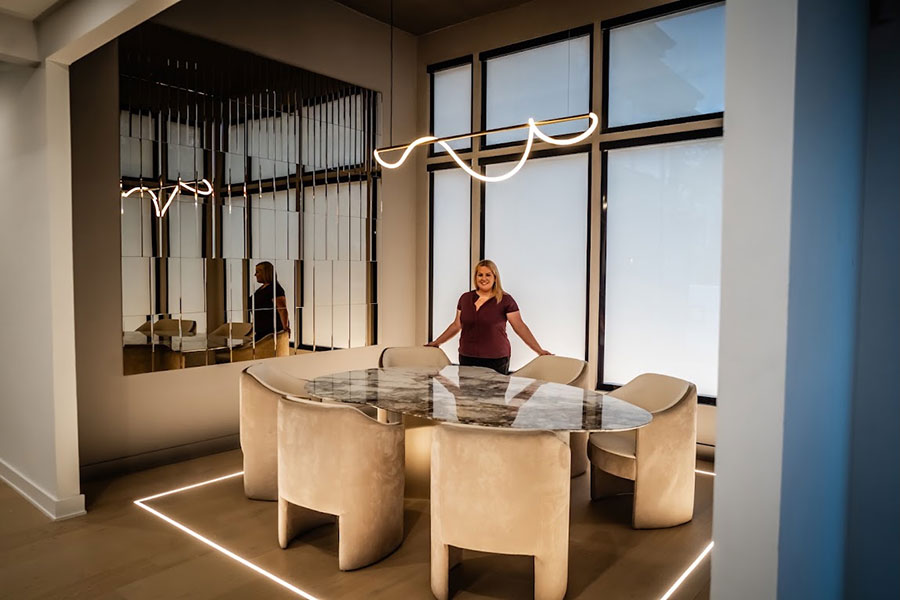
Is there anything I didn’t ask that you think I should have? Or is there anything you think that readers would want to know?
AL: I would just expand on the idea of relationships as you go off into the world. I always tell people that it’s so important to maintain relationships of all kinds and that people really remember the way you made them feel more than anything. You can switch companies. You can switch positions. You can go higher in rank, lower in rank. You can work for yourself. But, at the end of the day, your network is your net worth.
I’m in New York right now and I just was with two other alumni from IU. We’re still very much in contact. And we were just watching the Super Bowl, but we ended up having conversations about business, of course, and then a friend I was with is potentially going to work with one of these women. So, you just never know where your relationships will take you in the future and who-will-become-what and how they remember you as a person. And so, I just, you know, I don’t know that everyone thinks of that, but they should.
Thank you so much for your time, and good luck with everything!
AL: Thanks for your time! And thanks for choosing to write about me. I appreciate it.
Written By
Susan M. Brackney
Susan M. Brackney, BA’94, has been a professional writer since 1995. A member of the American Society of Journalists and Authors, she has written four nonfiction books, including Plan Bee: Everything You Ever Wanted to Know About the Hardest-Working Creatures on the Planet.